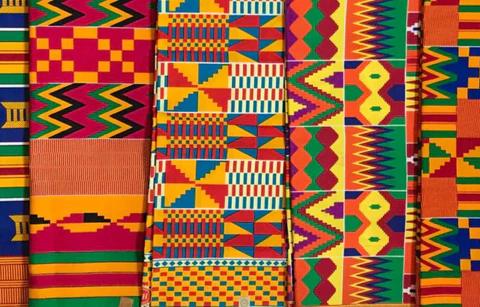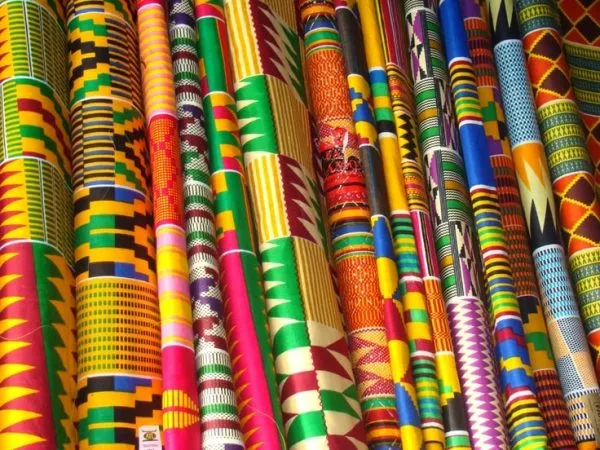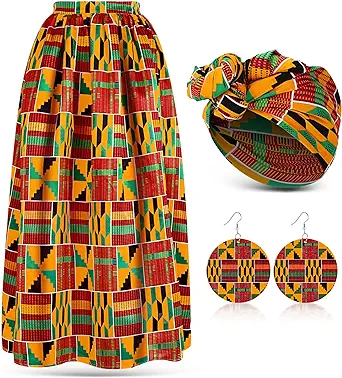From Ghana 🇬🇭 to the World: Kente Cloth's Global Impact and Influence
- la Djalobienne Eton

- Aug 18, 2023
- 4 min read
Updated: Jan 14, 2024
Kente cloth, a hallmark of Ghanaian textiles, is meticulously crafted through handwoven techniques, employing strips of silk and cotton. In historical context, this exquisite fabric adorned the regal figures of Akan society, draping them in a toga-like manner that spoke of their status. Its origin can be traced back to Bonwire, nestled within the Ashanti region of Ghana. In the contemporary Ghanaian landscape, the donning of Kente cloth has transcended its origins, becoming a widespread tradition to commemorate momentous occasions. The expertise of master weavers has propelled certain Kente brands into high demand, symbolizing excellence in craftsmanship.
The allure of Kente's intricate patterns has prompted the emergence of Kente print. This mass-produced rendition has found popularity within Ghana and resonates throughout Western cultures. This globally recognized print has even made its mark on the design of academic stoles, embellishing graduation ceremonies with its vibrant symbolism.
A Tapestry of History
The origins of Kente are deeply rooted in the Asante dialect's term "kenten," meaning "basket," reflecting the fabric's meticulously woven, basket-like intricacies. In the Akan community of Ghana, it is also known as "nwentoma," signifying a "woven cloth." Enriching the cultural tapestry is an Ashanti folklore tale narrating the journey of weavers inspired by Anansi, the revered spider, to create Kente's enchanting patterns.
This historical tapestry extends into the annals of time, interwoven with the Ashanti people's story, where Kente became a medium for expressing cultural identity and societal stature. Traditionally reserved for Ashanti royalty and nobility during significant ceremonies, Kente holds profound symbolic meanings within its intricate patterns and chosen color palettes, reflecting historical events, proverbs, and philosophical concepts. Beyond being a fabric, Kente emerges as a powerful visual language, a storyteller transmitting tales and values across generations.
Weaving Tradition, Craftsmanship, and Culture
Kente cloth production comprises three main categories: authentic handcrafted Kente by traditional weavers, vibrant Kente prints from brands like Vlisco and Akosombo Textile Ltd, and mass-produced Kente patterns, often from China and targeted at Western markets. Authentic Kente holds the highest value, while Kente print costs vary based on the production approach.
In the heart of the Ashanti region, towns like Bonwire, Sakora Wonoo, Ntonso, Safo, and Adawomase are luminous beacons of Kente weaving mastery, preserving the intricate craft through generations. The weaving unfolds on wooden looms, with dyed fabric threads intertwining in a dance. Weavers undergo traditional apprenticeships, honing skills for years under master weavers before creating unique patterns. Completed masterpieces bear individualized brand imprints for authenticity.
Kente cloth's distinctive feature lies in its elaborate weaving technique, executed on narrow looms. Slender woven fabric strips seamlessly amalgamate, creating intricate geometric motifs and designs. This process demands precision, patience, and a deep understanding of the cultural significance within each motif, emphasizing the profound narrative woven into every thread.
Crafting Heritage Through Color and Design
In the diverse world of Kente cloth, hundreds of distinct patterns, each with a thoughtful name or message, adorn its landscape. The complexity of these patterns varies, and the names of the fabrics in Ghana hold profound significance, derived from sources like proverbs, historical chronicles, revered leaders, matriarchs, and nature. Patterns predominantly characterize the lengthwise threads, and the connection between appearance and terminology is often enigmatic.
One example is "Ahwepan," a pattern embodying simplicity with meticulously woven warp stripes. While many Kente designs lean towards abstraction, some artisans incorporate eloquent words, numbers, and symbols. For instance, "Adweneasa" translates to "I've exhausted my skills," showcasing luxury with intricate weft-based patterns woven into plain weave blocks, requiring the involvement of three heddles. Kente cloth is a visual representation of the Ashanti worldview and cultural values. Colors hold profound meanings within Kente's designs. For instance:
Silver: serenity, purity, joy; associated with the moon
White: purification, sanctification rites, and festive occasions
Yellow: preciousness, royalty, wealth, fertility, beauty
Black: maturation, intensified spiritual energy, spirits of ancestors, passing rituals, mourning, and funerals
Blue: peacefulness, harmony, and love
Green: vegetation, planting, harvesting, growth, spiritual renewal
Gold: royalty, wealth, high status, glory, spiritual purity
Grey: healing and cleansing rituals associated with ash
Maroon: the color of Mother Earth; associated with healing
Pink: assoc. with the female essence of life, a mild, gentle aspect of red
Purple: associated with feminine aspects of life; usually worn by women
Red: political and spiritual moods; bloodshed; sacrificial rites and death.
Each pattern in Kente also carries significance. Some motifs represent unity, wisdom, leadership, and even social commentary. The cloth is often used to celebrate milestones such as births, weddings, and graduations, making it an essential part of life's journey within the Ashanti culture.
Tradition Meets Modernity
Over the years, the beauty and cultural significance of Kente cloth has transcended Ghana's borders. Its intricate artistry has captivated the world, and today, Kente is celebrated not only in Africa but across the globe. Kente symbolizes African pride, heritage, and unity from fashion runways to academic ceremonies. In a rapidly changing world, preserving cultural heritage is crucial. While skilled artisans still uphold the traditional methods of Kente cloth production, there's a new wave of appreciation for the craft. Contemporary designers are incorporating Kente patterns into modern fashion, bridging the gap between tradition and innovation. This ensures that Kente remains relevant and respected in the ever-evolving landscape of global culture.
The Kente cloth is a testament to the power of textiles to convey history, values, and artistry. Beyond its remarkable beauty, Kente is a living cultural artifact that reminds us of the rich tapestry of African heritage. Its intricate patterns, vibrant colors, and weaving techniques inspire awe and admiration, connecting us to a world of tradition and storytelling that spans generations. As we celebrate the Kente cloth, we honor the craft and the resilience, creativity, and cultural depth of the Ashanti people and the broader African continent.
Woven with reverence, Kente cloth whispers stories of Kings, dreams of Weavers, and echoes of Tradition. - La Djalobienne Eton
References:
- Kente cloth. (2023, May 26). In Wikipedia. https://en.wikipedia.org/wiki/Kente_cloth
- . (n.d.). Housebeautiful. https://housebeautiful.com/design-inspiration/a33670853/what-is-kente-cloth/ .
- Dr. Courtnay Micots, "Kente cloth," in Smarthistory, July 18, 2017, accessed August 18, 2023, https://smarthistory.org/kente-cloth/.










































Rich cultural heritage.